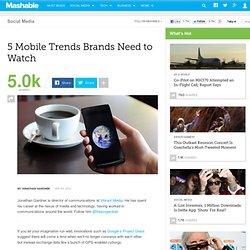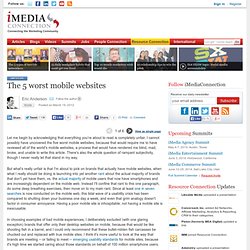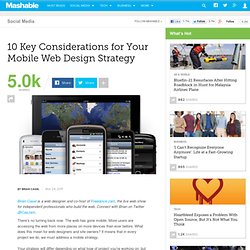

5 Mobile Trends Brands Need to Watch. Jonathan Gardner is director of communications at Vibrant Media.

He has spent his career at the nexus of media and technology, having worked in communications around the world. Follow him @thejongardner If you let your imagination run wild, innovations such as Google’s Project Glass suggest there will come a time when we’ll no longer converse with each other, but instead exchange data like a bunch of GPS-enabled cyborgs. While that may not be quite how it plays out, a highly-connected future is definitely on its way. Already, data shows that more than one third of American teens own an iPhone and the one-tablet-per-child initiative is a mainstay in South Korean and Thai schools. 1. Look in the mirror and what do you see? For example, the wizards at Corning provided an inspiring look at how touch screens made of glass might soon be seamlessly integrated into our environments. 2.
When I say biotech, I mean data comes from everywhere, including from within. App or mobile website: What's best for your business? The 5 worst mobile websites. Let me begin by acknowledging that everything you're about to read is completely unfair.

I cannot possibly have uncovered the five worst mobile websites, because that would require me to have reviewed all of the world's mobile websites, a process that would have rendered me blind, mad, broke, and unable to write this article. There's also the whole question of rampant subjectivity, though I never really let that stand in my way. Why Mobile Commerce is On the Rise [INFOGRAPHIC] About 30% of mobile phone users spend an average of about 27 minutes each day text messaging, using the telephone and video chatting, according to retailer CultureLabel.com.
![Why Mobile Commerce is On the Rise [INFOGRAPHIC]](http://cdn.pearltrees.com/s/pic/th/mobile-commerce-infographic-24551650)
The company put together an infographic that highlights the bright outlook for the mobile commerce industry, helped along by the massive growth of smartphone adoption. As CultureLabel looked to expand its own mobile strategy, the company compiled stats to reinforce the need to grow its m-commerce channel. According to its findings displayed in the online art retailer's infographic, 5.9 billion out of the 7 billion people (87%) worldwide already have mobile phones.
Sales - Four Ways to Use Mobile at Your Next Tradeshow Booth. At your next tradeshow, you'll likely be competing with numerous organizations for the attention of a finite pool of attendees.

Take into account, too, that those attendees have likely predetermined which booths they'll visit. The task of capturing (and keeping) their attention, therefore, is downright daunting. The solution may lie with mobile. The continual improvement of mobile technology has already made a significant impact on the world of tradeshow marketing. Consider, for example, how the use of QR (quick response) codes mirrored the adoption of smartphones. Pew: Smartphone Ownership Crosses Symbolic 50 Percent Threshold In US. With several qualifications and caveats, The Pew Internet Project released some new survey data (n=2,253) this morning that indicates 53 percent of US mobile phone owners now have smartphones.

This is higher than the most recent Nielsen number (48 percent) and quite a bit higher than the last-published comScore figure (42 percent). 388034-1: 10 Top Mobile Trends for 2012. Bankers Increasingly See Mobile as Key Element of Their Retail Strategies, American Banker Research Finds. Forecast: More US Mobile Web Users Than PC By 2015. It’s inevitable that in the not too distant future there will be more mobile internet users that those accessing the internet on a PC.

And today research firm IDC forecast that day will come in the US in 2015: By 2015, more U.S. Internet users will access the Internet through mobile devices than through PCs or other wireline devices. As smartphones begin to outsell simpler feature phones, and as media tablet sales explode, the number of mobile Internet users will grow by a compound annual growth rate (CAGR) of 16.6% between 2010 and 2015. There are a range of other predictions and forecasts in the report from which this is taken. IDC tracks mobile phone sales and shipments very closely; however the firm has a mixed record when it comes to forecasting future developments and ad revenues.
If more people in the US and around the world are accessing the internet on mobile devices (including tablets) can mobile search be far behind? 10 Key Considerations for Your Mobile Web Design Strategy. Brian Casel is a web designer and co-host of Freelance Jam, the live web show for independent professionals who build the web.

Connect with Brian on Twitter @CasJam. There’s no turning back now. The web has gone mobile. Enough With the Apps Already. I never know if one of my blog posts is going to take off.

Most don’t. But yesterday’s post about apps not being the future probably set some kind of record. It got a lot of links and a lot of reads. Had I known it was going to get so much attention I would have spelled out exactly what I meant by app. The question came up e-mailing with Brent Simmons who wrote a post about my post yesterday. Amazon Will Pay Shoppers $5 to Walk Out of Stores Empty-Handed - Tricia Duryee - Commerce. Amazon is offering consumers up to $5 off on purchases if they compare prices using the online giant’s mobile phone application in a store.

The promotion goes live Saturday and will serve as a way for Amazon to increase usage of its bar-code-scanning application, while also collecting intelligence on prices in the stores. This holiday season, mobile commerce is surging as more people become comfortable using applications on their phone to compare prices or simply shop when not at home or at work. On the Monday after Thanksgiving, the biggest online shopping day of the year so far, mobile sales reached 6.6 percent, jumping from 2.3 percent in 2010, according to IBM’s online retail study. Brad Spirrison: Mobile Apps Are a Big Part of GrubHub's Menu. Earlier this month, Chicago-based GrubHub gorged on another $50 million in venture capital financing.

While the seven-year-old startup success story will use much of that money to acquire a competitor, GrubHub will no doubt leave some room on its plate for mobile application development. GrubHub's apps for the iPhone and Android devices are great for when you are looking to place a food order while on the El on your way home from work. I'm not ashamed to admit I've tapped into both apps while on the couch, too lazy to actually get behind a computer to make my order. In any event, as GrubHub expands beyond the 19 U.S. cities in which it currently operates, you can bet that the company will pay as much attention to its mobile offerings as it does GrubHub.com. Sounds like a delicious strategy to me. FoodGenius on Android Food-focused startups and established companies alike are developing more iPhone apps and Android apps to cater to the rising mobile appetites of their consumers.
Timing, Location Count with Mobile CTRs. Mobile commerce platform Mobile Spinach provides a clue as to how mobile marketers can raise their CTRs: the provider says that its ability to display an offer that meets a user's "when," "what," and "where" criteria is key to converting clicks to actual sales. The company says publishers realize an average 8% click-through rate for its offers, with a 3% rate of customers going from a click to an actual converted sale. Industry averages for mobile ad click-through rates vary between 0.5% and 0.9%. This news follows a report from Nexage that advertisers are paying close to a 4x premium for location-enabled ads on its real time bidding platform and that demand for location-enabled impressions have shown a 170% per month growth over the past three months.
QR. Geolocation. Dev platforms. Smartphone stats. HTML5. Retail. Apps vs. Web. NFC.